New Mars Forums
You are not logged in.
- Topics: Active | Unanswered
Announcement
Pages: 1
#1 2018-12-31 19:50:09
- SpaceNut
- Administrator
- From: New Hampshire
- Registered: 2004-07-22
- Posts: 29,917
Landing legs
Space x has shown the value of the landing legs for being able to reuse a vehicle time and time again....
https://en.wikipedia.org/wiki/Falcon_Heavy
All three cores of the Falcon Heavy arrange the engines in a structural form SpaceX calls Octaweb, aimed at streamlining the manufacturing process, and each core includes four extensible landing legs. To control the descent of the boosters and center core through the atmosphere, SpaceX uses small grid fins which deploy from the vehicle after separation. Immediately after the side boosters separate, the center engine in each burns for a few seconds in order to control the booster's trajectory safely away from the rocket. The legs then deploy as the boosters turn back to Earth, landing each softly on the ground. The center core continues to fire until stage separation, after which its legs deploy and land back on Earth on a drone ship. The landing legs are made of carbon fiber with aluminum honeycomb structure. The four legs stow along the sides of each core during liftoff and later extend outward and down for landing.
.jpg/280px-Falcon_Heavy_Side_Boosters_landing_on_LZ1_and_LZ2_-_2018_(25254688767).jpg)
Legs for landing on the moon and on mars are going to be required...
I know that this has been discussed and thought that a collected volume of information on this one aspect might be useable in the design of ay of the items to land on a surface after doing an entry to the surface manuveur.
Offline
Like button can go here
#2 2018-12-31 20:04:33
- SpaceNut
- Administrator
- From: New Hampshire
- Registered: 2004-07-22
- Posts: 29,917
Re: Landing legs
"The payload penalty for full and fast reusability versus an expendable version is roughly 40 percent,"
Offline
Like button can go here
#3 2018-12-31 20:30:56
- SpaceNut
- Administrator
- From: New Hampshire
- Registered: 2004-07-22
- Posts: 29,917
Re: Landing legs
These are the current legs
but the ones for a BFR will be larger in length and more massive to support the intended structure....if they do not become part of the winglet structure which is one of the forms that mars seems to be getting...
Offline
Like button can go here
#4 2018-12-31 20:56:30
- louis
- Member
- From: UK
- Registered: 2008-03-24
- Posts: 7,208
Re: Landing legs
I thought the landing leg "fins" on the latest Starship design were two actuated and one fixed.
These are the current legs
https://external-preview.redd.it/WzFLlj … 3056a51421but the ones for a BFR will be larger in length and more massive to support the intended structure....if they do not become part of the winglet structure which is one of the forms that mars seems to be getting...
Let's Go to Mars...Google on: Fast Track to Mars blogspot.com
Offline
Like button can go here
#5 2018-12-31 21:14:02
- SpaceNut
- Administrator
- From: New Hampshire
- Registered: 2004-07-22
- Posts: 29,917
Re: Landing legs
This version is 3 equally space wings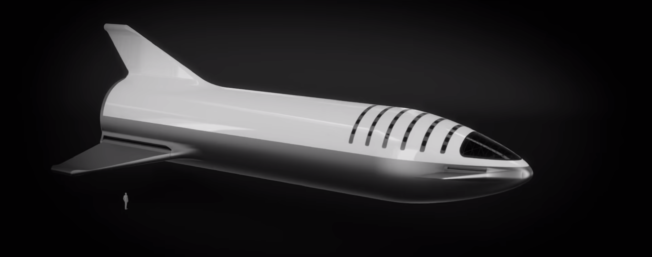
This one looks like the 2 dark fins are capable of swinging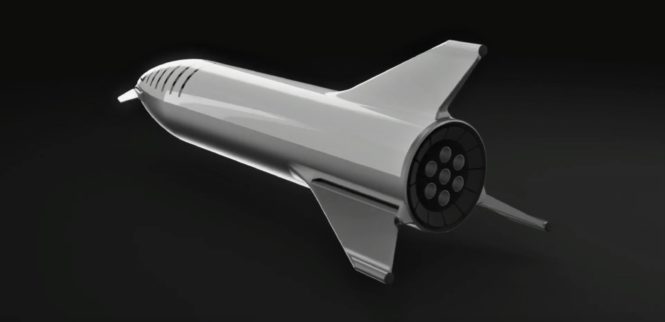
Offline
Like button can go here
#6 2019-01-01 12:42:27
- Oldfart1939
- Member
- Registered: 2016-11-26
- Posts: 2,488
Re: Landing legs
I suspect the "hopper version" will undoubtedly have fixed legs in place. No need for added complexity in first vehicle flights of a prototype.
Offline
Like button can go here
#7 2019-01-01 13:00:22
- SpaceNut
- Administrator
- From: New Hampshire
- Registered: 2004-07-22
- Posts: 29,917
Re: Landing legs
Which is what I have seem from the images posted about the Hopper unit but at some point for the BFR recovery as did Falcon they legs will need to be worked out and so will the upper stage winglets and feet as well....
Offline
Like button can go here
#8 2021-06-06 10:40:32
- tahanson43206
- Moderator
- Registered: 2018-04-27
- Posts: 23,455
Re: Landing legs
YouTube video showing closeup of landing legs Falcon 9 First stage.
https://www.youtube.com/watch?v=Tox9uu4QtMg
Here's a model of the legs showing possible action: https://www.instructables.com/Building- … ding-Legs/
(th)
Offline
Like button can go here
#9 2021-06-07 06:53:16
- tahanson43206
- Moderator
- Registered: 2018-04-27
- Posts: 23,455
Re: Landing legs
The message below was received from GW Johnson via the NewMars Portal.
Gary Johnson
Jun 6, 2021, 12:07 PM (20 hours ago)
to tahanson43206TH:
<snip>The diagram you want for "weight vector within footpad polygon" was Figure 20 in my "exrocketman" article "Reverse-Engineering the 2019 Version of the Spacex Starship/Superheavy Design", posted 22 October 2019.
GW
(th)
Thank you for the reminder of the location of the diagram to help with understanding the landing legs problem.
To find the article:
http://exrocketman.blogspot.com/
2019 has 28 articles
October has 5 articles
October 22nd is at the top
http://exrocketman.blogspot.com/2019/10 … on-of.html
Figure 20 is close to the bottom so it is faster to Ctrl/End and Page up to Figure 20
In studying the figure, I am reminded of the design of the Falcon 9 first stage landing legs ...
As I understand them, the legs are designed with hydraulic (air is the likely medium) cylinders that are collapsed while stowed inside the leg during launch, and which extend when the legs are released at the top to swing down.
It should be noted that such a design ** may ** be capable of handling off-center or sloping situations.
In fact, I would assume the Falcon 9 design ** already ** has some bounce built in to compensate for the surface upon which landing is attempted.
There is NO reason at all that the leg has to be a fixed structure without flexibility designed in from the beginning.
(th)
Offline
Like button can go here
#10 2021-06-12 19:32:35
- SpaceNut
- Administrator
- From: New Hampshire
- Registered: 2004-07-22
- Posts: 29,917
Re: Landing legs
GW Jonhson's latest post on his blog.
The idea is based on the Falcon-9 booster landing legs, modified to replace the one-shot extension tubes with a hydraulic cylinder. The idea is to hydraulically extend the legs for landing, and then hydraulically retract them after launch. Falcon-9's leg design cannot do that retraction after launch.
Offline
Like button can go here
#11 2021-06-12 20:10:58
- louis
- Member
- From: UK
- Registered: 2008-03-24
- Posts: 7,208
Re: Landing legs
I think you could get away with a lot less mass it you had three "wraparound" legs on the circumference of the rocket that extend out on landing and drop down to lock in position level to the bottom of the rocket.
Let's Go to Mars...Google on: Fast Track to Mars blogspot.com
Offline
Like button can go here
#12 2021-06-13 05:54:25
- tahanson43206
- Moderator
- Registered: 2018-04-27
- Posts: 23,455
Re: Landing legs
For Louis re #11
Would you be willing to provide a diagram of your idea? It sounds interesting, but the words you used are not helpful (to me at least).
Your preference is for the ease and convenience of words, but in this case, a simple hand drawn sketch would be worth a 1000 of them.
(th)
Offline
Like button can go here
#13 2021-06-13 13:21:48
- RobertDyck
- Moderator
- From: Winnipeg, Canada
- Registered: 2002-08-20
- Posts: 8,296
- Website
Re: Landing legs
GW Johnson's drawing included a flip-out pad or foot. But legs for Falcon 9 are shaped to provide strength, low mass, and enclose the hydraulic cylinder used to deploy the legs. This shape has a simple shaped end that acts as the foot. So no need for a separate "foot". My recommendation is just the same legs as Falcon 9, but scaled up for Starship.

Offline
Like button can go here
#14 2021-06-13 13:30:11
- RobertDyck
- Moderator
- From: Winnipeg, Canada
- Registered: 2002-08-20
- Posts: 8,296
- Website
Re: Landing legs
I've heard Falcon 9 uses hydraulics to deploy legs, but is that strictly correct? I expect it would be pneumatic. Hydraulic systems use a non-compressible liquid, usually a grade of oil. Pneumatic uses compressed air. Wouldn't it be lighter to use air or a gas? Until recently, legs couldn't be retracted. That means the telescoping cylinders that deploy the legs must have a catch that locks in place once extended. That way the cylinder won't compress when taking load, when the rocket lands on those legs and the cylinders take the weight.
Offline
Like button can go here
#15 2021-06-13 13:31:12
- SpaceNut
- Administrator
- From: New Hampshire
- Registered: 2004-07-22
- Posts: 29,917
Re: Landing legs
The Falcon design is for a base of 4 leg / feet of which the fins and need to have a heatshield makes it a version that is not balanced with 3 equally devided configurations so its got to have more to compensate for weird spacing....
Offline
Like button can go here
#16 2021-06-13 14:35:22
- RobertDyck
- Moderator
- From: Winnipeg, Canada
- Registered: 2002-08-20
- Posts: 8,296
- Website
Re: Landing legs
Elon was originally talking of using the fins as landing legs. That was before the fins could articulate. How strong are the hinges? Could he reduce mass by using the lower fins as landing legs? Would require reinforcement, but if that additional mass is less than a pair of legs, then it reduces total mass. Falcon 9 uses 4 legs. Could Starship use 2 landing fins, and 2 deployable legs? Yup, that means one leg would be in the middle of the heat shield. That means heat shield over that one leg. Outside only, not part toward the tank, and not the deployment cylinder. In fact, the body of Starship under the leg while the leg is retracted does not require heat shield. Because heat shield on the retracted leg provides that. Of course the leeward leg doesn't need any heat shield.
Offline
Like button can go here
#17 2021-06-13 16:53:06
- SpaceNut
- Administrator
- From: New Hampshire
- Registered: 2004-07-22
- Posts: 29,917
Re: Landing legs
Here is what they are building
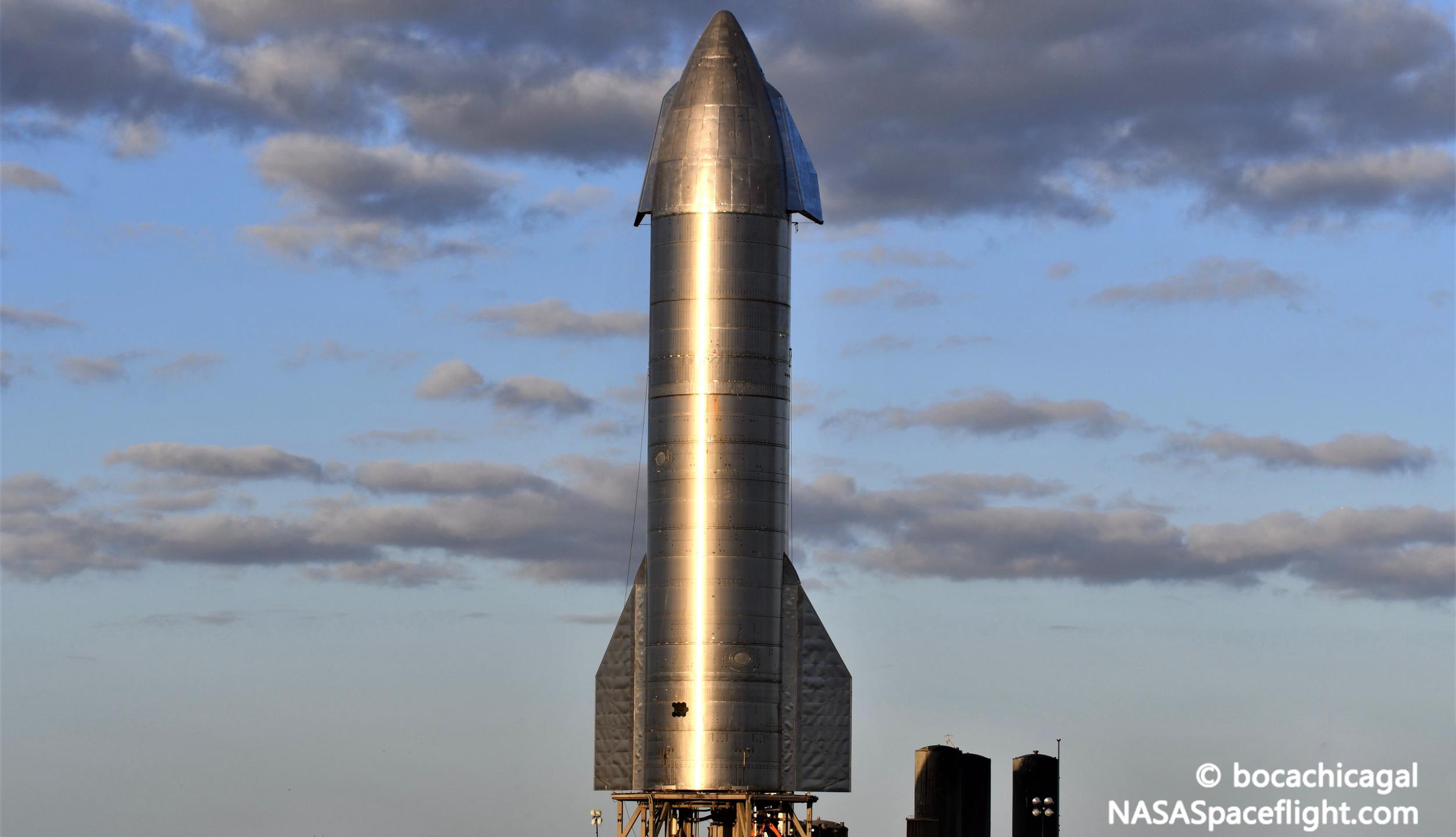
Offline
Like button can go here
#18 2021-06-13 19:15:26
- RobertDyck
- Moderator
- From: Winnipeg, Canada
- Registered: 2002-08-20
- Posts: 8,296
- Website
Re: Landing legs
SpaceNut: yea, with temporary legs. As GW Johnson said, those stubby little legs will not work on soft uneven ground. If Starship lands with one leg off the concrete landing pad on Earth, it will tip over. We already saw that when a rocket falls on its side, the fuel tank breaks open, fuel spills out, when the fuel reaches the flame from the rocket engine, it catches fire and burns. That happened with DC-XA. On the Moon or Mars, you have no hope of finding a flat, level, hard landing pad. Elon Musk has said the current legs are temporary, within SpaceX they're debating what the final legs will be.
Offline
Like button can go here
#19 2021-06-16 06:49:26
- NewMarsMember
- Member
- Registered: 2019-02-17
- Posts: 1,803
Re: Landing legs
This post is from GW Johnson via the NewMars portal.
I am happy to provide this service while GW Johnson figures out how (or even if) he will replace the laptop he recently retired from service.
Gary Johnson
Tue, Jun 15, 2:38 PM (18 hours ago)
to meI just posted a second landing leg concept on "exrocketman". This one uses link bars to put the extended leg in a vertical positrion, eliminating bending in the leg in favor of just compression. That enables a lighter leg, but stance gets reduced. The height to stance ratio is not as good as the first concept. I also came up with a slide-out-and-rotate pad for the end of the leg that eliminates the big pad hinge moment, and greatly reduces bending in the pad structure. This pad design could be used with either concept. The two concepts sort-of bound the design tradeoff space between lots of bending driving heavier legs but with a better height/stance ratio, and compression-only lighter legs that are associated with a poorer height/stance ratio (although still far better than the "stumpy little 6-legged freaks" flight testing right now). You might let the forum guys know.
GW
(th)
Recruiting High Value members for NewMars.com/forums, in association with the Mars Society
Offline
Like button can go here
Pages: 1
